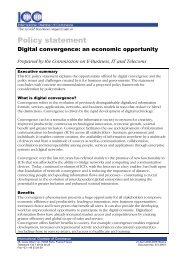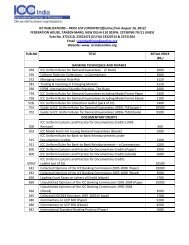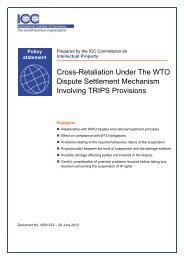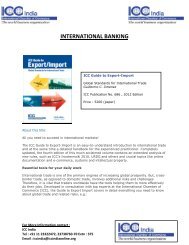2013 - ICC India
2013 - ICC India
2013 - ICC India
- No tags were found...
You also want an ePaper? Increase the reach of your titles
YUMPU automatically turns print PDFs into web optimized ePapers that Google loves.
<strong>ICC</strong> BANKING COMMISSION | <strong>2013</strong> GLOBAL RISKS TRADE FINANCE | APPENDIX C 69108 See “Table 1: Characterizing classical cycles (Quarterly data 1980‐2006Q2)” in Calderón,Fuentes (2010).109 Includes: Argentina, Bolivia, Brazil, Chile, Colombia, Costa Rica, Ecuador, Hong Kong, <strong>India</strong>,Indonesia, South Korea, Malaysia, Mexico, Paraguay, Peru, Philippines, Singapore, SouthAfrica, Taiwan, Thailand, Turkey, Uruguay and Venezuela110 Includes: Australia, Canada, France, Germany, Italy, Japan, New Zealand, Portugal, Spain,Sweden, United Kingdom and United States111 For the Emerging Economies more granular data is provided which shows a much widerrange than implied by this (with a minimum value of 1.1 and a maximum value of ~20 forColombia (and 10 for <strong>India</strong>)).112 In applying the figures from the paper we have used the more composite results presentedby the authors. As the paper only reports figures for 23 individual countries, we havemapped other countries to the most appropriate region if they are not named, except forChina where we have used the same ratio as for <strong>India</strong> (i.e. a ratio of 10, even though in theorythe figure for China may be higher given the lack of transactions). As this is for illustrativepurposes, where figures for individual countries were unavailable, we have used the reportedfigures for Latin America and Asia, or the Emerging Economies figure for non-OECDcountries in other regions.113 The former figure is based on weighting recessionary and expansion years by the value oftransactions in the Trade Register and the latter figure is based on weighting the year basedon the number of transactions in the Trade Register.114 We could in theory adjust the figures for this effect but have not done so in this year’sreport.115 In estimating EAD, there is no requirement to split the estimation in this way (i.e. by splittingit into two separate components), however we believe that where data permits, it may bebeneficial to do so in order to ensure that there is clarity on what is being measured andwhy the CCF may not be 100% on certain factors. Unfortunately, at this stage the <strong>ICC</strong> TradeRegister does not allow the two components to be split out.116 The difference is for commitments, Note Issuance Facilities and Revolving UnderwritingFacilities where a 75% CCF is used.117 §83(i) of BCBS (2006). This is the rule for Standardized (and hence Foundation) CCFs, but§316 BCBS (2006) indicates that Advanced firms can only use their own estimates “providedthe exposure is not subject to a CCF of 100% in the foundation approach”. There are someother exposure types where a CCF of 100% is required but they are not considered relevantfor this paper, so are not mentioned.118 To see this, consider overdraft products. In general, as firms approach default they may tryto draw on their available limit in order to avoid default, and hence their drawdown on theavailable limit may be higher than other firms. Therefore estimating additional drawdownson the whole population would risk underestimating the actual exposure at default fordefaulting firms.119 Note this is just an example rather than an ex ante expectation – if anything one mightexpect that firms who default may be less “organised” and therefore more likely to fail toprovide appropriate documentation.120 In addition, in a recession firms there may be more firms defaulting who are generally betterorganized, and hence more likely to have completed documentation appropriately.121 Even if documents are rejected on first presentation, provided that compliant documentsare presented within the timeframes specified in the contract, the bank may need to make apayment.122 §460, BCBS (2006)123 Basel rules require that (emphasis added), “A bank must estimate an LGD for each facilitythat aims to reflect economic downturn conditions where necessary to capture the relevantrisks. This LGD cannot be less than the long-run default-weighted average loss rate givendefault calculated based on the average economic loss of all observed defaults within thedata source for that type of facility. In addition, a bank must take into account the potentialfor the LGD of the facility to be higher than the default-weighted average during a periodwhen credit losses are substantially higher than average.” §468, BCBS (2006).124 It might well be the case that recoveries are subsequently made or even that the differencebetween write-offs and defaulted exposures is equal to the recoveries.125 This suggests that either there are substantial write-offs from prior years being carriedforward, or there are significant write-offs or recoveries yet to be realised.126 In this treatment it is assumed that the ratio of recoveries to write-offs on outstandingexposure is the same as that on exposure which has been recovered or written off. So forexample if defaulted exposure is 200, recoveries are 60 and write-offs are 40, then weassume that on the remaining exposure of 100 (=200 – 60-40), the recovery rate is the sameas for the 100 already completed (i.e. 60%). This would imply a recovery rate of 60% vs. 30%(=60/200) under our current approach.127 In this treatment it is assumed that recoveries are equal to the defaulted amount minus theexposure. So for example if we have defaulted exposure of 200 and write-offs of 80, thenthe recoveries would be 120, to produce a recovery rate of 60%, compared to a recovery rateof 0% in our current approach.











